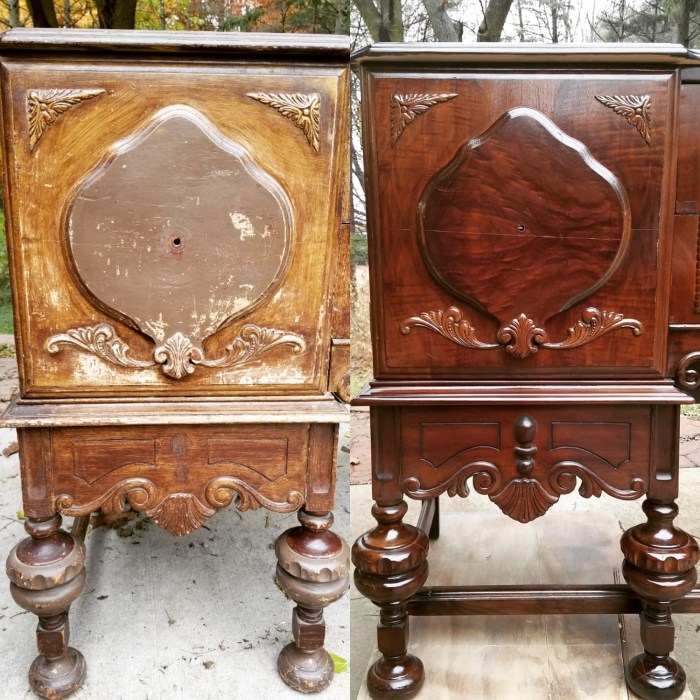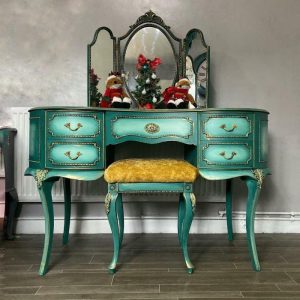
Antique furniture restoration is more than just fixing broken pieces; it’s a meticulous process that breathes new life into historical artifacts. This journey delves into the art and science of reviving these treasures, exploring the historical context, essential techniques, and the ethical considerations involved in preserving a tangible link to the past. From understanding the nuances of different wood types to mastering refinishing techniques, we’ll uncover the secrets behind restoring antique furniture to its former glory.
We will examine the various tools and materials needed, common restoration challenges, and the crucial steps involved in preserving the integrity of these valuable pieces. Furthermore, we’ll explore the impact of restoration on the value of antique furniture and compare this cost to purchasing already restored items. A comparison between antique and vintage furniture will also be included, highlighting key differences in style, materials, and construction.
Introduction to Antique Furniture Restoration
Antique furniture restoration is more than just repairing old pieces; it’s about preserving a tangible link to the past. These objects often hold historical and cultural significance, reflecting craftsmanship, design trends, and even the lives of previous owners. The process of restoration, therefore, involves a careful balance of preservation and intervention, aiming to maintain the integrity of the piece while making it safe and usable for future generations.The historical significance of antique furniture restoration lies in its contribution to the understanding of past societies and their artistic expressions.
Restored pieces become valuable artifacts, offering insights into woodworking techniques, materials used, and evolving design aesthetics across different eras. By preserving these objects, we contribute to a deeper understanding of social history, technological advancements, and cultural evolution.
Types of Antique Furniture Commonly Restored
A wide variety of antique furniture pieces undergo restoration. Common examples include chairs (ranging from simple Windsor chairs to elaborate Louis XVI styles), tables (including dining tables, writing desks, and side tables), chests of drawers, wardrobes, and beds. Specific styles frequently encountered include Victorian, Georgian, Queen Anne, and Art Deco pieces, each presenting unique challenges and requiring specialized knowledge for appropriate restoration.
The materials themselves also vary greatly, encompassing various hardwoods like mahogany, walnut, oak, and cherry, as well as softer woods like pine, and often incorporating veneers, inlays, and decorative metalwork.
Ethical Considerations in Antique Furniture Restoration
Ethical restoration prioritizes the preservation of the original piece over imposing modern aesthetics. It requires a deep understanding of the object’s history, construction methods, and materials. The key ethical principle is to only undertake interventions that are absolutely necessary to stabilize the piece and prevent further deterioration. Unnecessary modifications or replacements, which alter the original character or value, are ethically problematic.
For instance, while repairing a broken leg is acceptable, replacing it entirely with a new piece of wood might be deemed unethical unless absolutely unavoidable. Furthermore, transparency regarding the restoration process is crucial. A complete record of all interventions, including materials used and techniques employed, should be maintained to ensure accountability and to provide future conservators with essential information.
This meticulous record-keeping is vital for preserving the historical integrity of the piece and maintaining its value.
Materials and Tools Used in Restoration

Antique furniture restoration requires a careful selection of materials and tools to ensure the preservation of the piece’s historical integrity and aesthetic value. The right materials will protect the wood and enhance its natural beauty, while the appropriate tools allow for precise and controlled work, minimizing the risk of damage. Choosing the correct materials and tools is paramount to achieving a successful restoration.
Wood Types Commonly Found in Antique Furniture
Understanding the characteristics of different wood types is crucial for effective restoration. Different woods react differently to cleaning, repair, and finishing processes. The following table Artikels some common species, their properties, restoration challenges, and typical finishes.
| Species | Characteristics | Restoration Challenges | Common Finishes |
|---|---|---|---|
| Mahogany | Rich reddish-brown color, strong, durable, beautiful grain | Can be susceptible to checking (cracking) and insect infestation; filling requires careful color matching. | Shellac, varnish, French polish |
| Oak | Strong, durable, open grain, light to dark brown | Can be difficult to repair large gouges or scratches due to the open grain; prone to water damage. | Oil, varnish, polyurethane |
| Walnut | Rich brown to dark brown color, strong, fine grain, often figured | Can be prone to sapwood discoloration; requires careful cleaning to avoid damage to the delicate finish. | Shellac, varnish, oil |
| Cherry | Light reddish-brown color, becomes darker with age, fine grain | Can be easily scratched or dented; requires careful handling during cleaning and repair. | Shellac, lacquer, oil |
Essential Tools for Antique Furniture Restoration
A well-equipped workshop is essential for successful restoration. The tools listed below represent a core set for undertaking most restoration projects, though specialized tools may be required depending on the specific piece and its condition. Investing in high-quality tools will improve the precision and longevity of your work.
The following tools are crucial for most antique furniture restoration projects:
- Various screwdrivers (flathead, Phillips, and specialized antique screwdriver bits)
- Hand planes (smoothing plane, block plane)
- Chisels (various sizes)
- Mallet
- Clamps (various sizes and types)
- Sandpaper (various grits)
- Scrapers (card scraper, cabinet scraper)
- Brushes (various sizes and types for applying finishes)
- Wood glue
- Putty knives
- Measuring tools (ruler, tape measure)
- Safety glasses and dust mask
Workspace Preparation for Furniture Restoration
A well-organized and safe workspace is paramount for effective and safe restoration. Adequate space, proper lighting, and effective dust control are essential for preserving both the furniture and the restorer’s well-being. This preparation significantly impacts the quality and efficiency of the restoration process.
- Choose a suitable location: Select a well-ventilated area with ample space to comfortably work around the furniture piece. Consider a dedicated workshop or a large, well-lit room.
- Clean the workspace: Thoroughly clean the area, removing any debris or obstacles that could interfere with the restoration process. Ensure the floor is clean and protected with drop cloths or other protective coverings.
- Set up lighting: Good lighting is essential for detailed work. Use a combination of overhead lighting and task lighting to illuminate the work area from various angles.
- Organize tools and materials: Arrange tools and materials in an organized manner, easily accessible for efficient workflow. Consider using tool chests or organizers to keep everything neat and tidy.
- Ensure proper ventilation: Open windows or use exhaust fans to ensure good ventilation, especially when using solvents or finishes. A respirator or dust mask is recommended to protect against airborne particles.
- Protect the work surface: Cover the work surface with drop cloths or protective padding to prevent scratches or damage.
Restoring antique furniture is a rewarding endeavor that combines craftsmanship, historical understanding, and a deep appreciation for the past. By carefully considering the ethical implications, employing the correct techniques, and understanding the value of preservation, we can ensure these beautiful pieces remain a cherished part of our cultural heritage for generations to come. The process, though detailed and requiring patience, yields stunning results, transforming damaged pieces into objects of beauty and historical significance.
The knowledge gained through this process allows for a deeper appreciation of the artistry and craftsmanship of bygone eras.
Key Questions Answered
What is the difference between antique and vintage furniture?
Generally, “antique” refers to items over 100 years old, while “vintage” typically signifies items from the mid-20th century (roughly 1930s-1960s) possessing desirable aesthetic qualities.
How much does antique furniture restoration cost?
Costs vary widely depending on the piece’s size, condition, and the type of restoration needed. It’s best to obtain quotes from several professional restorers.
Can I restore antique furniture myself?
While possible for minor repairs, complex restorations are best left to professionals to avoid causing further damage. Simple projects can be attempted with careful research and practice.
How do I find a reputable antique furniture restorer?
Seek recommendations, check online reviews, and verify credentials. Look for restorers with experience and a commitment to ethical restoration practices.







